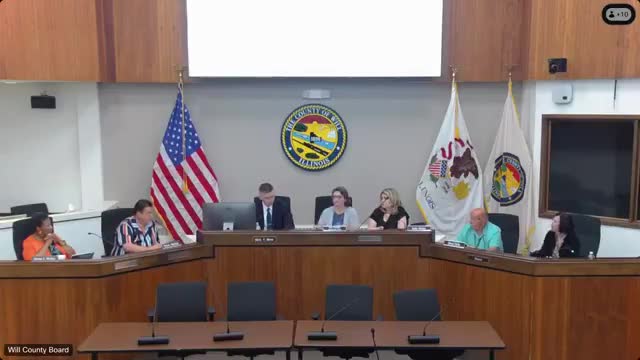Homer Glen committee debates five-year transportation project plan approval
July 04, 2025 | Will County, Illinois
This article was created by AI summarizing key points discussed. AI makes mistakes, so for full details and context, please refer to the video of the full meeting. Please report any errors so we can fix them. Report an error »

In the heart of Will County, Illinois, the Public Works & Transportation Committee convened on July 1, 2025, to discuss a pivotal five-year infrastructure plan that has sparked both support and dissent among committee members. The atmosphere was charged as discussions unfolded, revealing the complexities of local governance and community needs.
The meeting began with a call for clarity on the proposed five-year plan, which aims to address various transportation projects across the county. However, not all committee members were on board. One member, Mr. Balanch, expressed his intention to vote against the plan, citing unresolved issues that he felt needed addressing before proceeding. This sentiment echoed through the room, highlighting the tension between progress and community concerns.
Mr. Oxley, a newer member of the committee, raised critical questions about the plan's implications for local townships, particularly Homer Township and Homer Glen. He emphasized the importance of engaging with township authorities, noting that many residents had voiced their opposition to the project. His inquiries pointed to a broader issue of communication and collaboration between different levels of government, which is essential for ensuring that community voices are heard.
The discussion turned technical as committee members delved into the specifics of the project. Questions arose regarding the right-of-way requirements for different road configurations. A consultant had previously assessed the impact of reducing the planned five-lane road to a three-lane design, but the findings suggested that the changes might not significantly lessen the required land acquisition. This revelation underscored the challenges of balancing infrastructure needs with property rights and community sentiment.
As the meeting progressed, the timeline for the project also came under scrutiny. Some members pondered the possibility of delaying certain phases of the plan, particularly on the western side of the county, to allow for further community engagement and assessment. However, constraints tied to federal funding complicated these discussions, particularly for the eastern side of the project.
Amidst the technicalities, Ms. Hickey reminded the committee that all projects listed in the plan had undergone previous votes and approvals. She urged her colleagues to focus on the current task of adapting the plan rather than revisiting past decisions. Her call for resolution highlighted the need for the committee to move forward, whether by adopting the plan or voting it down.
As the meeting drew to a close, it became clear that the path ahead for Will County's transportation infrastructure is fraught with challenges. The committee's deliberations reflect a microcosm of the broader struggle between development and community engagement, a balancing act that will shape the future of the region. With decisions looming, the committee's next steps will be crucial in determining how effectively they can address both infrastructure needs and the voices of the residents they serve.
The meeting began with a call for clarity on the proposed five-year plan, which aims to address various transportation projects across the county. However, not all committee members were on board. One member, Mr. Balanch, expressed his intention to vote against the plan, citing unresolved issues that he felt needed addressing before proceeding. This sentiment echoed through the room, highlighting the tension between progress and community concerns.
Mr. Oxley, a newer member of the committee, raised critical questions about the plan's implications for local townships, particularly Homer Township and Homer Glen. He emphasized the importance of engaging with township authorities, noting that many residents had voiced their opposition to the project. His inquiries pointed to a broader issue of communication and collaboration between different levels of government, which is essential for ensuring that community voices are heard.
The discussion turned technical as committee members delved into the specifics of the project. Questions arose regarding the right-of-way requirements for different road configurations. A consultant had previously assessed the impact of reducing the planned five-lane road to a three-lane design, but the findings suggested that the changes might not significantly lessen the required land acquisition. This revelation underscored the challenges of balancing infrastructure needs with property rights and community sentiment.
As the meeting progressed, the timeline for the project also came under scrutiny. Some members pondered the possibility of delaying certain phases of the plan, particularly on the western side of the county, to allow for further community engagement and assessment. However, constraints tied to federal funding complicated these discussions, particularly for the eastern side of the project.
Amidst the technicalities, Ms. Hickey reminded the committee that all projects listed in the plan had undergone previous votes and approvals. She urged her colleagues to focus on the current task of adapting the plan rather than revisiting past decisions. Her call for resolution highlighted the need for the committee to move forward, whether by adopting the plan or voting it down.
As the meeting drew to a close, it became clear that the path ahead for Will County's transportation infrastructure is fraught with challenges. The committee's deliberations reflect a microcosm of the broader struggle between development and community engagement, a balancing act that will shape the future of the region. With decisions looming, the committee's next steps will be crucial in determining how effectively they can address both infrastructure needs and the voices of the residents they serve.
View full meeting
This article is based on a recent meeting—watch the full video and explore the complete transcript for deeper insights into the discussion.
View full meeting
